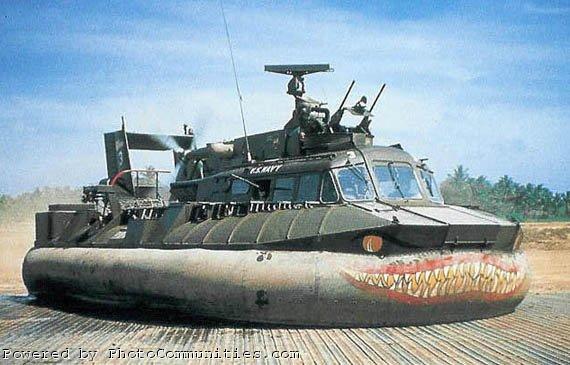|
U.S. Army Combat Hovercraft "SK5" Gun Boat.
The SK-5 hovercraft was extensively used in Vietnam for patrol and
interdiction missions in the Mekong Delta.
The British company Hovercraft supplied seven vehicles of the type
BHC SR.N5 to the American company Bell of aero system. After the re-equipment
on General Electric Lm-100 gas turbines received the hovercrafts the
designation Bell Sk-5 Model 7232. Three as PACV or Pak Vees (Patrol
air Cushion Vehicles) designated units (004, 017 and 018) went to test
purposes to the U. S. Navy into Viet Nam, where they were stationed
in Cat Lo. From there it operated in 1966 for eight months long. In
January 1967 they went to the general overhaul and re-equipment back
into the USA, before they returned 1968 for a further year to Viet Nam
(there Nang and Tan My). Starting from 1968 they stood in the service
of the Coastal division 17.
The PACVs was to be operated in a the position with high speed (70
kn) in the march and sumpfgebieten of Viet Nam, their employment accompanied
however with a high noise generation of the gas turbines. Also to high
mechanical loads they had obviously not sufficiently been up to, so
that them of the soldiers of the Riverine Force altogether not when
optimal resources were regarded. Compared with the PBRs (Patrol Boat
River) the air cushion vehicles were more expensive also around a multiple
in the acquisition
In July of 1965, the US Navy bought three hovercrafts Sr-n5 model 7232
of Bell Aerosystems Company. They were imported boats of the British
Hovercraft Corporations and had been modified with shield and a machine
gun rank, and changed the engine for a T-58 turbine of General Eletric
who developed 1300 HP and the radar for an American model.
In 1965, hovercrafts had been assigned by the US Navy as PACV (Patrol
Air Cushion Vehicle). Extensively search missions of and destruction
in lands of the Delta of the River Mekong 1966 had been used by the
Tf-116 in the 1967 in division PACV 107.
The US Navy operated seven PACV (Patrol Air Cushion Vehicle) in the
Vietnam. The Tf-116 used three between 1966-1967.
The fast PACV were e easily operated in plain canals and quagmires,
passing easily for obstacles and on land. However, very barulhentos
and they were sophisticated for the marginal operations. For using aviation
technology they were expensive and difficult to keep. They consume fuel
in amount extreme. The current projects have automobile standard and
engines diesel and are well more trustworthy and cheap.
These models 7232 could develop 52 we and carry 17 equipped combatants.
The costs of maintenance of the 7232 were similar to the one of a jet
aircraft. The price of each hovercraft was next to a dollar million.
In 1967 the US Navy modified these extensively hovercrafts endowing
with decks straight (the previous ones were rounded off), the improved
skirts, greater has storaged of fuel and a brought up to date engine.
In 1968 they had been transferred to the coastal area of Danang. Later
they had been repassed for Coastal Guarda of San Francisco.
The result was beyond the waited one, as much that the US Army decided
for in use in the Vietnam its proper ACV (Air Cushion Vehicles). The
US Army ordered a perfected version of model 7232, called Sk-5 Model
7255. AACV (Assault Air Cushion Vehicle) had three models beyond one
in the transport version (load and staff) call TACV (Transport Air Cushion
Vehicle).
To I oppose it of the models of the US Navy that "had been militarized",
the models of the US Army had been constructed specifically military
use. The armament was heavier with 2 Browning machine guns 50 and a
thrower of garnet of 40mm automatic equal M5 model to used in the Bells
Ah-1 the Snake. The transport version was armed only with 2 M-60 machine
guns of 7.62 mm. The shield was added in the laterals and special in
the positions of the pilot, the radar operator and the artillerymen
of the M5 and the 2 machine guns 50 as well as for the more sensible
mechanical components.
The models of the US Army had represented an important advance in the
warlike use of the Hovercrafts therefore its "skirts" were
secionadas, allowing to one better substitution and repair. Possuíam
also a slope, that better made possible them load and discharge of staff
and equipment. It could load a mule mechanics or a Jeep equipped with
a cannon without jib of 106mm.
The Sk-5 was equipped with a General turbine Eletric Lm-100-pj102 that
developed 1250 Hp the 21,000 rpm. It carried 300 gallons from fuel and
it operated with a radius of action of 165 nautical miles. Its endowment
was of 7 members of the crew and could load 12 infants total equipped.
They had entered in action in 1968 with 39ª Cavalry of 9ª
Division of Infantry. They had operated in areas flooded and marshy
as well as in firm land. In 1968 it had 4 Divisions PACV in the US Army.
The Navy of Brazil tried the Hovercraft of Bell in 1968. In the climates
of the Amazônia they do not obtain to develop more than 20-24
we. Also the edges could not adentrar therefore the forest did not allow.
|